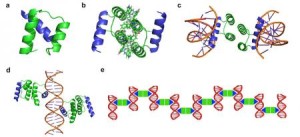 Researchers have developed completely new nanowires by combining synthetic DNA and protein.
Researchers have developed completely new nanowires by combining synthetic DNA and protein.
Through combining these two promising synthetic biological materials to form nanowires, the door to promising applications requiring biomaterials has been opened.
While both synthetic DNA and synthetic protein structures show great potential in the areas of direct delivery of cancer drugs and virus treatment customization, the hybridization of materials provides even more advantages.
“If your material is made up of several different kinds of components, it can have more functionality. For example, protein is very versatile; it can be used for many things, such as protein–protein interactions or as an enzyme to speed up a reaction. And DNA is easily programmed into nanostructures of a variety of sizes and shapes,” said first author of the study, Yun (Kurt) Mou.
Drug Delivery and Gene Therapy
The protein-DNA nanowire hybrid biomaterial still requires a generous amount of work before it enters commercialization, but the researchers involved believe it has the potential to change research and clinical practices.
“Our next step will be to explore the many potential applications of our new biomaterial,” Mou says. “It could be incorporated into methods to deliver drugs into cells—to create targeted therapies that only bind to a certain biomarker on a certain cell type, such as cancer cells. We could also expand the idea of protein–DNA nanowires to protein–RNA nanowires that could be used for gene therapy applications. And because this material is brand-new, there are probably many more applications that we haven’t even considered yet.”
[Image: Caltech]PS: Head over to the Digital Library to learn more about nanowires!


